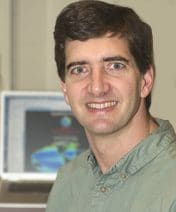Press Room
A new study strengthens evidence that the oceans and climate are linked in an intricate dance, and that rapid climate change may be related to how vigorously ocean currents transport heat from low to high latitudes.
The release of the preliminary report of the US Commission on Ocean Policy today offers an opportunity to set a new national course in the conservation, management and wise use of the oceans, say scientists at the Woods Hole Oceanographic Institution (WHOI).
Dumping iron in the ocean is known to spur the growth of plankton that remove carbon dioxide, a greenhouse gas, from the atmosphere, but a new study indicates iron fertilization may not be the quick fix to climate problems that some had hoped.
Alvin, the nation’s only deep-diving research submersible capable of carrying humans to great depths to explore the sea floor, reached another milestone in its long career April 12 when the sub made its 4,000th dive.
The Woods Hole Oceanographic Institution’s new 60-foot coastal research vessel (CRV) Tioga was christened and launched March 29, 2004 in ceremonies at Gladding-Hearn Shipbuilding, Duclos Corporation in Somerset, MA.
Senior Scientist Robert Detrick has been appointed Vice President for Marine Facilities and Operations at Woods Hole Oceanographic Institution (WHOI), effective July 1, 2004.
Philanthropist and Texas Instruments co-founder Cecil H. Green took special pleasure in giving away more than $200 million during his 102 years, a portion of it to the Woods Hole Oceanographic Institution (WHOI). His generosity to WHOI continues after his death with the announcement of a $500,000 gift from The Cecil and Ida Green Foundation.
Woods Hole Oceanographic Institution (WHOI) Scientist Scott Doney has been chosen one of 20 academic environmental scientists from throughout the U.S. and Guam for a 2004 Leopold Leadership Fellow.
ALVIN, the nation’s only deep-diving human occupied submersible, will mark a number of milestones in 2004. In April, the sub, currently at work in the eastern Pacific, is expected to make Dive #4,000. In early June, the sub will celebrate […]
The growing number of ocean observatories in both coastal and deep waters around the country are providing scientists with a presence in the ocean 24 hours a day seven days a week. WHOI has built and deployed a number of […]
Woods Hole Oceanographic Institution (WHOI) scientists and their international colleagues will be at sea off Hawaii in June trying to learn more about the ocean’s ability to store atmospheric carbon dioxide. Its all part of a new two-year program called […]
Woods Hole Oceanographic Institution (WHOI) is one of the ten best places to work for postdoctoral researchers, according to a recent survey of readers of the magazine The Scientist. WHOI ranked eighth in the top ten US institutions.
Tropical ocean waters have become dramatically saltier over the past 40 years, while oceans closer to Earth’s poles have become fresher, scientists reported today in the journal Nature. Earth’s warming surface may be intensifying evaporation over oceans in the low latitudes–raising salinity concentrations there–and transporting more fresh water vapor via the atmosphere toward Earth’s poles.
For the first time since 1960, US scientists will be able to explore the deepest parts of the world’s oceans, up to seven miles below the surface, with a novel underwater vehicle capable of performing multiple tasks in extreme conditions. Researchers at the Woods Hole Oceanographic Institution (WHOI) are developing a battery-powered underwater robot to enable scientists to explore the ocean’s most remote regions up to 11,000 meters (36,000-feet) deep.
The longest piston coring system in United States will be built at the Woods Hole Oceanographic Institution, allowing scientists to sample ancient sediment on the sea floor that is potentially rich with information about ocean and climate history.
Scientists from the Woods Hole Oceanographic Institution (WHOI) have identified a new type of ocean ridge that is spreading so slowly that Earth’s mantle is exposed over large regions of the sea floor. Their findings of a new ultraslow class of ridge, reported in the November 27 issue of the journal Nature, offer a major change in thinking about the formation of the great crustal plates that make up the surface of the earth.
Scientists studying the formation of the sea floor thousands of feet below the surface have a new theory for why there are so many holes and collapsed pits on the ocean bottom. In a recent article in the journal Nature, the researchers say the holes and pits of various sizes are probably formed by lava erupting onto the seafloor so quickly it traps water beneath it, forming bubbles of steam that eventually collapse as the water cools. The hardened crust then breaks, forming pock marks and glassy black plates of ocean crust with stalactites on their underside.
A number of remotely operated and autonomous underwater vehicles developed and operated by Woods Hole Oceanographic Institution (WHOI) to explore the world’s oceans are featured in the new television program “Robots of the Deep,” scheduled for national premier on the Science Channel Friday, November 7, at 9 p.m. EST.
Two veteran journalists today received the first Woods Hole Oceanographic Institution (WHOI) Ocean Science Journalism Award for their contributions to the public understanding of oceanography. The award, which comes with a $5,000 cash prize and memento, was presented in two categories, print and broadcast journalism, at ceremonies at the Asia Society and Museum in New York City.
A new application of a decades-old technique to study Earth’s interior is allowing scientists “see” the layers in the ocean, providing new insight on the structure of ocean currents, eddies and mixing processes. The findings, reported in this week’s Science by a team from the University of Wyoming and Woods Hole Oceanographic Institution (WHOI), could be a major step forward in the ability to remotely survey the interior of the ocean.

